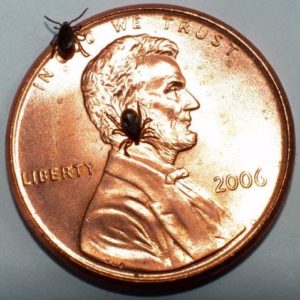While warmer weather calls for fun outdoors, it also beckons pests. In particular, ticks are in abundance and can cause a host of health problems for you, your family, and your pets. Protect your yard from these pests by knowing how to detect, prevent, and kill ticks.
Identifying Ticks
Depending on the species, ticks vary in color, ranging from gray, brown, black, and even reddish in tone. Ticks experience four life stages: egg, six-legged larva, eight-legged nymph, and adult. Ticks begin their lives with six legs in their larval state, but they develop eight legs as nymph and into adulthood. In terms of size, ticks are smaller than a sunflower seed, measuring about a quarter inch in length when full grown. They feed on blood, needing it in their diet to transition through the four stages of their life cycle. Meaning, most species of tick must make contact with a new host four times in its lifetime to make it to adulthood. Without successfully finding a host, ticks die before completing their three-year life cycle.
To access the blood they need, ticks attach to a live host. Ticks have a wide-spread presence in the Northeast, making them common in yards and parks. What determines their host is mainly a matter of proximity, so if ticks are in your yard or favorite park, you, your family, and your pets are at risk of becoming their host. Once attached, ticks embed themselves for a period of time, often days. They feed on the blood of their host until they are full, which can take several days to two weeks. At that point, the tick detaches from its host, falling off and continuing on its way.
Recognizing Tick Risks
Ticks can become a serious problem for the health of your family and pets, since these outdoor pests embed themselves on a person or animal to feed for up to a few days. In the meantime, they can transfer diseases such as Lyme disease, Rocky Mountain Spotted Fever, and others. Add that to how difficult they are to remove and how are so commonly found in yards, and ticks are more than just a nuisance.
The transfer of disease happens through the tick’s feeding process. When a tick finds a feeding spot on its host, it cuts into the skin’s surface. Once the tick has attached and inserted its feeding tube into the skin of its host, the tick begins collecting blood. If the host animal has a blood-borne infection, the tick will ingest the pathogens from the host with its blood. The tick then carries the pathogens in its saliva. When the tick attaches to its next host, the pathogens in its saliva can infect the subsequent host. Through this contact, ticks transmit disease from host to host.
Detecting Ticks
Due to their size, ticks are not commonly seen until they attach themselves to your pet or family member. In fact, if you see your pet scratching at a tick, you may mistake it for a flea. Unlike fleas, however, ticks will embed themselves on animal or human hosts for a period of time, as mentioned, often days. Therefore, it’s important to inspect yourself and others after being outside, especially in wooded areas. In fact, its best practice when outdoors in or near woods to frequently check for the presence of ticks on your skin and clothing. While inspecting yourself and others for ticks, keep in mind their identifiers. Look for a small eight-legged brown, grey, or black bug. Note, if left to their own devices without immediate detection, ticks can expand, filling with blood. Be sure to remove ticks as soon as they are observed. To remove ticks safely, follow CDC guidelines.
Preventing Ticks
 To help prevent tick bites, keep your landscaping well-maintained, use tick repellent, such as inspect spray, and wear long-sleeved clothing when outdoors. For added protection, contact Western for our Integrated Tick Control Program, which reduces tick populations on your property.
To help prevent tick bites, keep your landscaping well-maintained, use tick repellent, such as inspect spray, and wear long-sleeved clothing when outdoors. For added protection, contact Western for our Integrated Tick Control Program, which reduces tick populations on your property.
The best way to rid your yard of these unwanted guests is to never attract them to begin with.
Ticks are not only disconcerting; they can be dangerous. To minimize tick infestations and keep your family safe, follow these guidelines:
- Grass: Eliminate tick hiding spots by keeping high grass to a minimum by mowing your lawn frequently. Keeping your lawn short will help keep ticks out of the picture.
- Litter: Maintain your yard by keeping your yard clean. Ticks love hiding in piles of leaves, sticks, and any shady spots. By removing these potential hiding spots, you help protect your family from exposure to ticks.
- Trim Foliage: To further eliminate shady hiding spots, trim the trees and bushes around your yard. Maintaining your yard with careful attention to shade producing landscaping will help reduce tick activity.
- Repellents: Use tick repellents and sprays. Be sure to use effective repellents, by checking out the CDC’s website for up-to-date information on repellent recommendations and read labels carefully.
- Pest Management: Invest in a targeted tick management program, like that offered by Western. By involving a professional, you can keep your yard and family tick-free without cutting into your outdoor and family time.
In fact, Western has an expert-designed and implemented Integrated Tick Control Program. Western professionals can assess your yard for conducive conditions and help develop and provide a monthly barrier spray protection plan that will help keep your yard tick-free.
Ticks are not only annoying, but dangerous. If not properly handled, they could put you and your family at risk. If you feel like your yard is being taken over, don’t hesitate to contact the professionals at Western Pest Services.